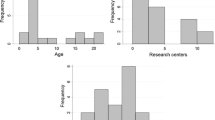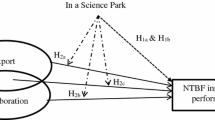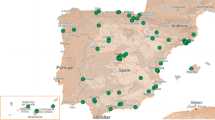Abstract
We analyse the results of a survey conducted by the Bank of Italy in the spring of 2012 on Italian science and technology parks. First we describe the main features of science parks in Italy. Then we investigate whether they have been effective in improving the economic performance and innovative capacity of the firms located within them. We find a pronounced heterogeneity between science and technology parks, whose cooperation with public research institutions is characterized by physical proximity. Although the business situation of firms located in science and technology parks tends on average to be better than that of similar “non-park” firms, a difference-in-differences estimation shows that entering a science and technology park did not generally improve firms’ business performance and their propensity to innovate compared with external counterparts.

Similar content being viewed by others
Notes
See for example Wallsten (2004) and Hu (2007). The former studies whether the clustering effect of SPs in UK have a positive effect on the employment and the venture capital in the areas close to SPs. Hu (2007) instead analyses whether the Chinese SPs provide some benefit in terms of higher productivity. For more recent contributions see also Squicciarini (2008).
For example, Colombo and Delmastro (2002) study the effectiveness of 17 SPs and 25 BICs (Business Innovation Centers) on the propensity to innovate of the incubated firms. However, focusing also on BICs, which may actually have different goals with respect to SPs, makes their analysis on science parks’ activity biased. Furthermore, their study was performed more than 10 years ago, when many of the Italian SPs were just born. In a more recent contribution Salvador (2011) studies the role played by the SPs and BICs on Turin universities spin-offs performance.
To the best of our knowledge, the only paper that tries to make a similar overview, but for the Spanish science parks is Barge-Gil et al. (2011).
Interestingly, all SPs have their main partnering university in the same region, often in the same province, suggesting a significant cooperative activity with other local knowledge institutions.
For example, a firm with a higher absorptive capacity (Cohen and Levinthal 1989) may find more profitable entering in a park because it can get a larger technology transfer benefits compared to its competitors.
In their paper the Colombo and Delmastro (2002) do not find a significant difference between the two groups. However, they find that firms inside SPs or business incubators are endowed with a stronger human capital (hence they should have a larger absorptive capacity), they tend to be more connected with other research institutions and, consequently, they participate to international research projects more than firms outside the parks. Recall however, that in their paper the authors where considering both Science Parks and Incubators.
See the website http://www.apsti.it for further details.
See Appendix 3 for a translated version of the questionnaire. For whom interested, the original (Italian) version is available upon request to the authors.
Looking at only science parks belonging to the APSTI then 20 over 27 SPs participated to our survey.
As a matter of fact, PatStat is a dataset that collects all the patents applied to the European Patent Office. For our purposes, we use the dataset created by Giovanni Marin which merges the firm level data by AIDA Bureau Van Dijk with patents data by the European Patent Office. For further details about PatStat and its merging with AIDA see Lotti and Marin (2013). It is worth metioning that the overlap between balance sheet datasets (CeBi and Cerved) and AIDA-PatStat dataset is 70,039 records over 70,115, hence almost 100 %.
Even though to a lesser extent, the same occurs even if we consider the turnover of the SP.
In particular, the Ward and Centroid methods, which are the most common clustering algorithms provide different distances, hence different orderings, of the SPs. We also tried to overcome this problem by considering the turnover of the SP in the cluster analysis. Unfortunately, also in this case results were too sensitive to the clustering method adopted.
This average does not take into account the five SPs without firms in their area.
Obviously, such close localization of the main partner does not mean that SPs do not cooperate with others settled elsewhere.
By “Project management” we mean a long term support to the strategy of the project, in according to costs, timing and objectives. We defined “Partnership” service as assistance in joint ventures and other cooperative agreements, support in the relationships with other public institutions etc.
Results on the other qualitative answers (like turnover variation in the last 5 years, number of services provided to firms etc.) are available upon request by the author.
We do not discuss here the clustering method applied to our data. For whom interested, see Appendix 1.
We did not compare the performance of these firms also in the pre-treatment year because many firms were born in the parks and, moreover, the pre-treatment year is different among firms of different parks, making the analysis less informative.
Data shown in these tables are obtained by keeping the dataset from the 5th to 95th percentiles.
All the p values of these tests are well below the 1 %, for whom interested the tests can be asked upon request to the authors.
Note that the difference in the ratio intangible investment/sales is not clear cut probably because both numerator and denominator are higher for SP firms.
Other matching methods employs the propensity score (Rosenbaum and Rubin (1983)), that is a synthetic and one-dimensional index based on the co-variates chosen. In our exercise the Mahalanobis matches performed better both in term of number of matched firms that in term of balancing properties of the matched samples. For a detailed overview on the propensity score analysis see also Guo and Fraser (2010).
As a matter of fact, the decision of asking only the year of settlement of the first firm is due to keep the questionnaire as light as possible, hence to increase the response ratio.
For example, if the first year of settlement of the science park A is (say) 2005, we (do not) consider for our analysis only the firms created before (after) such year.
We perform the Kolmogorov–Smirnov and the Kruskal–Wallis tests to which we add the Shapiro–Wilk and the Shapiro–Francia test for normality. We did not used the Shapiro–Wilk and the Shapiro–Francia in the previous section because these tests can be applied only for samples that goes between 4-2000 and 5-5000 observations respectively, a condition that was not met in our general analysis. These results about these tests are available upon request by the authors.
We also reports the results of the t tests as a benchmark. Moreover, the number of matched observations is lower for the investments variables because they are created as the differences between the assets in t and t + 1, leading us to built them on a 4 years balanced sample. As a consequence we have a reduction of the number of firms due to the presence of more missing values.
As regard the investment, we have a smaller number of observations than the other outcomes because we need to have the stock variables in two subsequent years to compute the investment.
The 3 years delay is justified by the fact that the SP firm needs some time in order to benefit of SP services. To make the comparison possible we then applied the same number of years to the pre-treatment period, going back from the year of settlement in the Park. For example, if the SP firm settled in 2005, we considered its patent application treatment period from 2008 to 2011, hence 4 years; as a second step we account four years of pre-treatment period (i.e. 2002–2005). Note also that few of the matched firms had a positive patent application stock, generating a very low variability of the dependent variable.
Note that, even though, sales and added value increase respectively of around 83 and 55 per cent due to the treatment; these effects are not particularly strong if we think of the small average values shown for the considered firms.
About the remaining six SPs that we could have included in the counter-factual analysis, three were too old such that balance sheet data of their SP firms in the pre-treatment period were not available; while the others were too young to be included in the analysis such that SP firms moved inside these parks too recently.
Obviously we are not able to control for the exact length of treatment for each firm, but we assume that the length of the treatment is equal for the firms that are settled in each park. Therefore, the length of the treatment for each park is constructed considering the difference between 2011 and the year of settlement of the first firm in it.
Recall that the are also 4 parks that have no firms inside their area, suggesting that they are less business-oriented.
We did not check the common trend assumption for patents because it is a variable with few values different from zero such that it is high unlikely that the common trend assumption is violated.
Note that the different size of the two groups is due to the fact that many parks have the same median year of first settlement i.e. 2005. In order to make the two groups comparable we put these firms to the group of the oldest parks. Clearly, the adjective old is used in a relative sense.
As for the analysis Recent versus Old parks, the concept of “old” firms is relative and related to the need of building up two comparable sub-samples basing the median value of the firms’ age.
For whom interested on incubated firms, a very recent paper Auricchio et al. (2013) sheds light on the role played by Italian Business Incubators on firms’ survival capacity with respect to non-incubated firms. Their work is therefore quite complementary to ours not only because of their survival analysis, but also because they look at another tool used by policy makers to improve the entrepreneurship and the competitiveness in Italy.
For a recent analysis on the effect of industrial districts on firms’ performance see Bertamino et al. (2013).
Actually, the number of firms signalled by the interviewed SP was initially 703, however a first check lead us to drop 96 of them because they were public entities.
There also exists non hierarchical Cluster analysis where it is assumed a priori the number of groups that has to be created at the end of the analysis. For further details see Gatignon (2007).
References
Auricchio, M., Cantamessa, M., Colombelli, A., Cullino, R., Orame, A., & Paolucci, E. (2013) Gli incubatori di impresa in Italia. Questioni di Economia e Finanza (Occasional Papers), No. 216, Banca d’Italia.
Barge-Gil, A., Modrego, Rico A., Paraskevopoulou, E., & Rocio Vasquez Urriago, A. (2011). The impact of science and technology parks on firms’ product innovation: Empirical evidence from Spain. Journal of Evolutionary Economics, 24(4), 835–873.
Bertamino, F., Bronzini, R., De Maggio, M., & Revelli, D. (2013) I distretti tecnologici italiani: caratteristiche ed effetti sulla performance delle imprese, mimeo Banca d’Italia.
Bigliardi, B., Dormio, A. I., Nosella, A., & Petroni, G. (2006). Assessing science parks’ performances: Directions from selected Italian Case studies. Technovation, 26(4), 489–505.
Capello, R., & Morrison, A. (2009). Science parks and local knowledge creation: A conceptual approach and an empirical analysis in two Italian realities. In New directions in regional economic development. Chapter 13, pp. 221–245.
Chan, K. F., & Lau, T. (2005). Assessing technology incubator programs in the science park: The good, the bad and the ugly. Technovation, 25(10), 1215–1228.
Cohen, W. M., & Levinthal, D. A. (1989). Innovation and learning: the two faces of R&D implications for the analysis of R&D investment. Economic Journal, 99(397), 569–596.
Colombo, M., & Delmastro, M. (2002). How effective are technology incubators? Evidence from Italy, Research Policy, 31(7), 1103–1122.
Felsenstein, D. (1994). University-related science parks- ‘seedbeds’ or ‘enclaves’ of innovation? Technovation, 14(2), 93–110.
Gatignon, H. (2007). Cluster analysis. In J. Abonyi & B. Feil (Eds.), Statistical analysis of management data (pp. 295–322). Berlin: Springer.
Guo, S., & Fraser, M. W. (2010). Propensity score analysis, statistical methods and applications. Beverly Hills, CA: SAGE Publications Inc.
Hu, A. G. (2007). Technology parks and regional economic growth in China. Research Policy, 36(1), 76–87.
Link, A., & Scott, J. (2003). U.S. science parks: The diffusion of an innovation and its effects on the academic missions of universities. International Journal of Industrial Organization, 21, 1323–1356.
Link, A., & Scott, J. (2006). U.S. university research parks. Journal of Productivity Analysis, 25(1), 43–55. Springer.
Lotti, F., & Marin, G. (2013) Matching of PATSTAT applications to AIDA firms—discussion of the methodology and results. Questioni di Economia e Finanza (Occasional Papers) No. 166, Banca d’Italia.
Rosenbaum, P. R., & Rubin, D. B. (1983). The central role of the propensity score in observational studies for causal effects. Biometrika, 70(1), 41–55.
Salvador, E. (2011). Are science parks and incubators good “brand names” for spin-offs?. The case study of Turin. Journal of Technology Transfer, 36(2), 203–232.
Squicciarini, M. (2008). Science parks’ tenants versus out-of-park firms: Who innovates more? A duration model. Journal of Technology Transfer, 33(1), 45–71.
Wallsten, S. (2004) Do science parks generate regional economic growth? An empirical analysis of their effects on job growth and venture capital. Joint Center for regulatory Studies Working Paper, March 1–17.
Zhang, Y. (2008). Related and supporting industries: The macro dimension of science park management. International Journal of Entrepreneurship and Innovation Management, 8(1), 57–73.
Zhao, Z. (2004). Using matching to estimate treatment effects: Data requirements, matching metrics, and Monte Carlo evidence. The Review of Economics and Statistics, 86(1), 91–107.
Acknowledgments
We wish to thank Raffaello Bronzini, Matteo Bugamelli, Luigi Cannari, Guido De Blasio, Alessandro Fabbrini, Luigi Infante, Francesca Lotti, Giovanni Marin, Andrea Orame, Davide Revelli, Francesco Venturini, Giorgio Calcagnini, Germana Giombini and the referees for their insightful comments and suggestions. We are also grateful to the participants in the workshops on innovation held at the Bank of Italy (26–27 September 2012 and 19 March 2013), the DMQTE seminar at the Università “G. d’Annunzio” of Pescara, and the International Conference on Technology Transfer at the Università degli Studi “Carlo Bo” di Urbino. We are also indebted to Luca Missori for his invaluable assistance in creating the questionnaire and collecting data and to our colleagues of the regional research offices for helping us in collecting the list of science parks. The opinions expressed in this paper are those of the authors and do not necessarily represent those of the Bank of Italy.
Ethical standard
The authors ensures the quality and integrity of the research made and no conflict of interest can be related to the research made in this paper. As already stated in the acknowledgements, the opinions expressed in this paper are those of the authors and do not necessarily represent those of the Bank of Italy. The usual disclaimers apply.
Author information
Authors and Affiliations
Corresponding author
Appendices
Appendix 1: Cluster analysis
To check the specialization of a SP we used the name of firms provided in our survey to get their information from CeBi/Cerved and Infocamere datasets. For the purpose of this paper we look in particular at their economic sectors according to the ATECO 2007 classification, which corresponds to ISIC rev.4 and NACE rev. 2.
We have been able to get the 2-digit industry sectors of 548 firms out of 609 firms mentioned in the surveyFootnote 41 covering almost the 90 % of the sample. Knowing in which SP each firm is established, then we were able to see which sectors and how many firms-per-sector are present in each SP.
To detect the degree of specialization we then considered two variables. The first one is the number of sectors existing in the park thanks to the presence of a firm: the higher number, the less specialized is the park. However, this variable can be misleading because a SP may have many sectors but almost all the firms operating in a particular one while another could have fewer sectors but firms more uniformly distributed along them. Therefore we also calculated a concentration (Herfindhal) index for each SP according to the number firms per each sector existing in the SP.
We used these two variable in order to perform a cluster analysis. To avoid the sensitivity of results to different variable unit measures, we normalized the data according to the following rule
which is suitable for non negative values as in our case. In order to see which group of SPs naturally arise, cluster analysis is based on hierarchical methods.Footnote 42 We considered the Ward method as our benchmark because of its large use. To check the robustness of our clustering with respect to the method used we also used Centroid, Average, Weighted average and Complete methods. For all of them, the ordering of the SPs according to the dissimilarity measure is the same. Centroid did not produce a dendrogram so it was not possible to use it. Concerning the other methods, as the dissimilarity measure increases, the number of groups passes from five to three. However, in case of five groups one cluster is made of an isolated SP, a result that is difficult to evaluate. On the other hand, if we consider a higher dissimilarity level to associate the isolated SP with another group, we have three groups that differ according to the method used. Given these drawback and the higher use of Ward algorithm we use the latter.
Appendix 2
See Appendix Tables 22, 23, 24, 25, 26 and 27.
Appendix 3: Questionnaire




Rights and permissions
About this article
Cite this article
Liberati, D., Marinucci, M. & Tanzi, G.M. Science and technology parks in Italy: main features and analysis of their effects on the firms hosted. J Technol Transf 41, 694–729 (2016). https://doi.org/10.1007/s10961-015-9397-8
Published:
Issue Date:
DOI: https://doi.org/10.1007/s10961-015-9397-8




